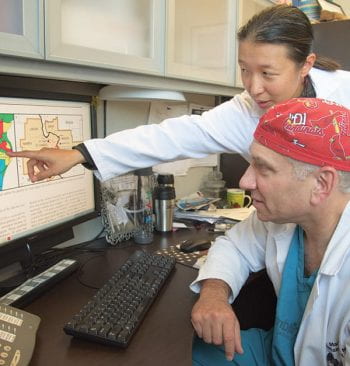Life-Support Refinements Reduce Complications

Six-month-old Avory Flare’s life was saved twice at St. Louis Children’s Hospital. Avory was born with a condition called congenital diaphragmatic hernia, in which his left diaphragm didn’t form. As a result, organs normally found in the abdomen moved into the left side of his chest, impairing the development of his heart and lungs.
Avory was so sick at birth that he needed a treatment of last resort, extracorporeal membrane oxygenation (ECMO), to save his life. Surgery soon after birth to repair the hernia was another life-saving measure. Since then, he has had five additional surgeries to repair organs.
The team that administered Avory’s ECMO celebrated its 30th anniversary this year after providing its 1,000th treatment in July 2015. In recent years, these specialists also have made the treatment safer by implementing a new protocol detailing several new measures to control bleeding, ECMO’s most common complication. The result: better outcomes for a wide range of patients, including newborns like Avory.
“ECMO supports patients with reversible respiratory or cardiorespiratory failure,” says Division Chief Brad Warner, MD, the Jessie L. Ternberg, MD, PhD Distinguished Professor. “Blood is taken out of the body, moved through the ECMO circuit that does the work of the heart and lungs, and then returned to the patient. We provide blood-thinning medicine to prevent clotting, in order for the pump to work, but this puts patients at risk for potential bleeding complications.”
No center has the perfect solution for controlling bleeding, says Adam Vogel, MD, who led the protocol development. For many years, the standard method to gauge the effectiveness of anticoagulation therapy has been the activated clotting time blood test. The new protocol includes additional tests such as anti-Xa and thromboelastography to direct anticoagulation therapy, along with transfusion of red blood cells and other blood products
A division study found that the incidence of major bleeding complications in ECMO patients decreased from about 45 percent to 20 percent in the 18 months after protocol implementation. The team also increased the use of veno-venous ECMO — in which blood is removed from a vein and returned to a vein — rather than a circuit that returns blood to an artery. Veno-venous ECMO is associated with better circulation.
“ECMO is an incredible technology,” says Vogel. “We learn more about it every day.”
Highlights

Martin Keller, MD, medical director of trauma, was senior author of a study that provided a troubling picture of firearm injuries and deaths among St. Louis-area children. The study found that from 2008 to 2013, 398 children ages 16 or under were taken to emergency rooms at St. Louis Children’s Hospital or Cardinal Glennon Medical Center in St. Louis for gun-related injuries. Of those children, 20 later died. Among the findings: Almost 78 percent of the children were African-American. About 82 percent of all firearm injuries, including deaths, occurred among boys, and the majority were African-American, median age 15. Thirty-five percent of the injuries resulted from accidental shootings, and the remainder from assaults. The study reports not only the frequency of such incidents, but also the contributing circumstances — information that could help identify risk factors and stem gun-related injuries.
Three lab residents made presentations on short-gut syndrome at the Academic Surgery Congress in February 2016: Lauren Muckleroy- Barron, MD, reported that giving an antibiotic in an animal model prevented development of liver injury associated with intestinal resection; Bola Aladegbami, MD, presented findings that genes regulated by oxygen deficiency affect blood flow and adaptation responses in the remnant intestine; and Raphael Sun, MD, described ways in which the protein mTOR may be involved in the gut’s response after resection.
Connie Lee, MD, a newly appointed instructor, will expand outreach at University of Missouri Women’s & Children’s Hospital in Columbia, where she will provide surgical services and support the hospital’s pediatric residency. (See New Faculty section.)